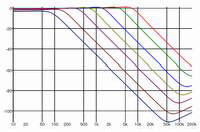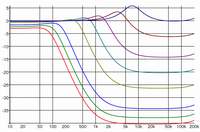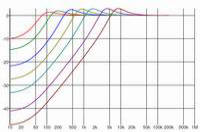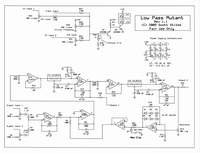The Mutant Vactrol Filter
Introduction
This is a tale of a project that took a direction based upon a simple wiring error on a breadboard.
I'd like to say it was a wiring error I noticed, and took a shine to. But, no, this is more of an oblivous error that I just carried on through until it became rather obvious to someone outside looking in. To use one of my favorite Seinfeld episode quotes "This is the most public yet of my many humiliations".
But, in truth, though it was not what I set out to create, by the time I'd figured out what was going on, I rather liked the result.
The first version was built with NPN switching transistors, rather than FETs, and it had a particularly agressive bite to it. Alas, I accidentally overwrote those schematics, so they are not anywhere to be found on this page. If you should get into building this filter, and would like to experiment, try rigging those FETs up with NPN transistors instead.
One of these days I will return to my original design plan, that of building a fairly standard Vactrol filter. I have breadboarded some really nice ones but have always managed to get attracted to some other shiny before I really documented what I'd done. One of these days.....the mantra of the Synth DIYer........
-Scott Stites, May 2010
A Foreword With Warning:
I feel a certain kinship with Dr. Frankenstein. He had troubles with the help as well. "Igor", he says, "go dig me up a brain of a Nobel prize winning physicist". What's Igor do? He runs out and grabs the brain of a recently deceased raving lunatic, and poor Dr. Frank embeds that in the skull of his historic life re-animation project. We all know how that turned out.
So, I tell my laboratory assistant Matthew, "Go dig up a couple of Buchla Low Pass Gates, I need them, dammit." Matthew lurches and stumbles to the great Buchla graveyard and digs up a couple of boards obviously built and discarded when Don was suffering from perhaps a bit of undigested beef. Well, what can one expect from a seven year old lab assistant? I put these things on the board, hoisted it up to the lightning rod, and lowered down a jibbering, frantic, insanely mutated filter. Far more mutated than I had expected.
That's my story, and I'm sticking to it.
Of course, another version of the story could go like this: A couple of years ago, I breadboard a couple of LPG's in series, slapped a resonance loop on them and saw that it was good. Alas, projects took precedence, and a couple of years later I decide to try it again. I'd drawn up schematics of my work before, and used those as a basis for my work. Without the resonance, things sounded pretty much the same, more or less - nothing to make me suspicious something was up. The resonance, though, took on a far different aspect. Instead of questioning the perfection of my project trascription powers, I started twiddling and twaddling with the circuit until the Mutant Filter sat upon the board, rolling its eyes and squawking odd sounds when its resonance was pushed. I was (and am) quite happy with it.
Flash forward a few months, to the Synth Diy list. Professor Aaron Lanterman, who is conducting what has to be the coolest University class in history at Georgia Tech - basically on makes synthesizers tick - posts a musing on resonance and the LPG. I post a blurb about the Mutant, providing a link to this very page. Imagine my chagrin when this post from Grant Richter, the brain behind the Wiard Synthesizer, arrives in my inbox:
"No offense, but don't you want the 4700 pF going to the OUTPUT of the op-amps? The circuit as drawn is not a Sallen Key or LPG that I have ever seen. If it works, you are on to something new."
I read this, went into the la-bohr-atory, checked the Mutant out, and sure enough - my out was in and my in was out, or something along those lines. Well, I'll be damned. Actually, I am damned, but this still surprised me. Other than the fact that it is not a Sallen-Key filter, and isn't what I'd originally set out to do, it still works. And works quite strangely.
Enter Ryan Williams, who a few days later, analyzed what one stage of the Mutant filter actually does and provided a comparison to what a Sallen-Key filter does. To Ryan I say thanks, because his work has lifted a curtain of mystery about what the hell this thing is actually doing.
Below are links to Ryan Williams' simulations:
Freak show. It is bizarre. And, no, it is not an S-K filter. In fact, the "24 dB and "12 dB" terms used on the following original text of my page seem to really apply to what frequency the filter is processing.
But when I turn out the light, I know that's it's mine. It can be yours, too, if you build it. Just don't build it and expect a normal synth filter, if such a thing exists. None of this alters the fact that the samples on this page were done with the Mutant Filter. If you like the sound of it, build it. If you don't, don't build it. Just don't build it and think you're building a Sallen-Key filter, or that it has much to do with the Buchla LPG, or that you're building a normal filter. You're building a Mutant Filter.
When the villagers arrive at your doorstep, carrying torches and pitchforks, don't blame me. You've been warned.
By the way, Ryan Williams has a great page here - lots of very interesting stuff, such as the best treatment of PT23XX delay IC's I've seen yet:
A Vactrol Based Insult to All That Is Holy.....
The Mutant Filter is so named because at its heart is the Sallen-Key structure of two Buchla Low Pass Gates (actually "not" as it turns out) with the embellishments of an expo current sink and a resonance clipper similar to that found in the Korg MS-20 filter. It is not a clone or an adapation - it's more of a mutation, an almagm metasticized from disparate elements. The result is a filter that can be sublime, organic, raucous or downright mean. At times it can be sublimly organic in its raucous mean-ness. Its sounds are legion, and the samples on this page are just a taste of the beauty and weirdness that can be wrought from it.
Before proceeding further, here is a composition using only the filter in various modes. It's a nice glimpse of the filter in actual use as opposed to the rather dry expository samples that follow. There's some organically sublime mean raucousness in there...somewhere.
The Mutant Filter In Detail
The resonance limiter was taken from Rene Schmitz's 'Late MS-20 Filter' design. I used regular signal diodes instead of the green LED's of Rene's design mainly because I couldn't find any green LED's around here at the time I was putting it on breadboard. Green LED"s would work just fine. The expo control is taken directly from Rene's 4069 VCO design.
I have an added switch which allows the lower half of the resonance signal to be clipped. Surprisingly, this is the tamer resonance mode (and sounds quite pleasing). When the resonance is not clipped, the filter will more freely self-oscillate and render some of the wilder MS-20 like resonance tones.
The Mutant Filter has six modes of operation:
| Mode 1 | 12 dB low pass with resonance tapped from the 24 dB low pass point. |
| Mode 2 | 24 dB low pass. |
| Mode 3 | 12 dB High Pass with resonance tapped from the 12 dB band pass point. |
| Mode 4 | 12 dB Band Pass. |
| Mode 5 | 12 dB High Pass with resonance tapped from the 24 dB high pass point. |
| Mode 6 | 24 dB High Pass. |
The modes are selected by setting a toggle switch to one of three positions and setting another toggle 'Tap' switch to either tap 1 or tap 2.
Modes 1 and 2
Two sections (just the Low Pass structure) wired in series allow a 24 dB response for Low Pass filtering. The resonance in this mode is clipped and inverted as it's fed back to the input. When the mode switch is set to the LP position, the 12 dB low pass response is present on the output when the tap switch is in position 1. The 24 dB low pass response is available when the tap switch is in position 2. Note that the resonance is always tapped from the 24 dB output.
Modes 3 and 4
Modes 3 and 4 configure the first section of the filter to a 12 dB high pass filter and the second section of the filter to a 12 dB low pass filter. The resonance in this mode is clipped and fed back to the input non-inverted. When the mode switch is set to the BP position, the 12 dB high pass response with resonance tapped from the band pass output is present on the output when the tap switch is in position 1. The 12 dB band pass response is available at when the tap switch is in position 2.
Modes 5 and 6
Modes 5 and 6 configure both sections of the filter to the 12 dB high pass configuration. The resonance in this mode is clipped and fed back to the input non-inverted. When the mode switch is set to the HP position, the 12 dB high pass response with resonance tapped from the 24 dB high pass output is present on the output when the tap switch is in position 1. The 24 dB high pass response is available at when the tap switch is in position 2.
Mutant Vactrol Filter Schematics
Click the link below to download the schematics, theory, notes and parts list for the Mutant Vactrol Filter. It contains the schematics for the deluxe version (which was used for all of the samples on this page) as well as single mode schematics for a Mutant Low Pass, Mutant Band Pass, and Mutant High Pass filter. It is an Adobe PDF formatted document.
Sound Samples
In case you missed it above, here is the first composition done with the Mutant Filter:
Here's another one. The voice with the crazy resonance, at first shrieking then later rather formant-like, is taken from the first tap (HP) with resonance taken from the second second tap (BP output). This filter is no shrinking violet =-D.
Controlled by Keyboard Samples
The following samples were made using a keyboard and the filter in all six modes. Note that the filter settings were not changed from sample to sample - this is to demonstrate what the modes do and would sound like just by clicking through the modes with a signal hooked up to the filter. The resonance is cranked up a bit in these samples. When I speak of mean-ness/raucousness, you'll probably detect that I'm usually referring to the resonant high pass modes.
12 dB Low Pass with Resonance from 24 dB Low Pass Output
12 dB High Pass with Resonance from Band Pass Output
I recorded a couple of samples of the LP configuration in 24 dB and 12 dB modes. I was intending to record all modes in this manner, but got sidetracked. I'll follow up on those. In the meantime, here are a couple of samples of the Low Pass mode. No EG or LFO is used, just keyboard tracking. Resonance is at minimum. These samples give a feel of the difference between the 12 dB and 24 dB modes.
The Obligatory Sequencer Samples
The following samples were done using the same sequence and VCO voicings. I controlled one of the VCO's with both the keyboard and the sequencer, and controlled the cutoff of the filter in part with the keyboard as well. Each sample more or less takes each mode through its paces with resonance, cutoff, etc. All but the last two high pass modes were recorded with the VCA open and no control upon it. The last two high pass modes have the VCA modulated by the same EG as the filter.
12 dB Low Pass with Resonance from 24 dB Low Pass Output
12 dB High Pass with Resonance from Band Pass Output
Filtering Frequency Modulated VCO's With Sample and Hold
One of the thing the 291 BPF and 292 LPG are very good at is producing pleasing tones in conjunction with a frequency modulated VCO. Below are some samples of the Mutant Filter processing the triangle output of a VCO modulated by the triangle output of another VCO. Both VCO's and the Mutant Filter are controlled by the 266 SH circuit I've put together.




